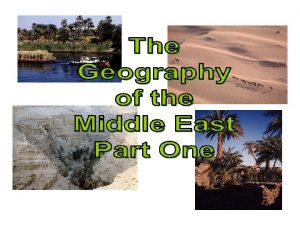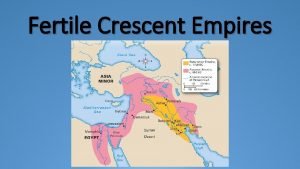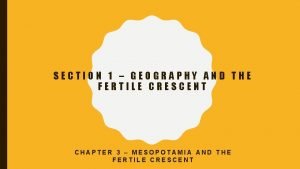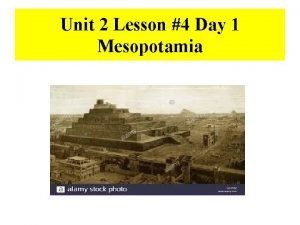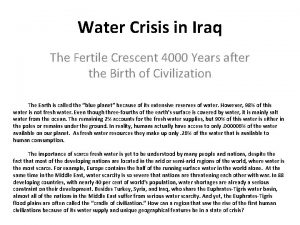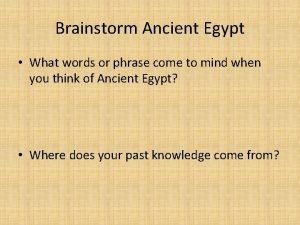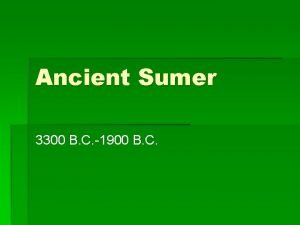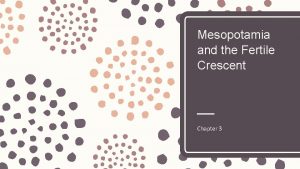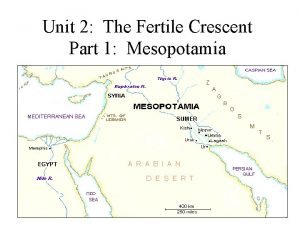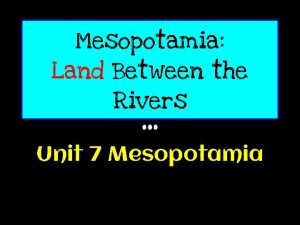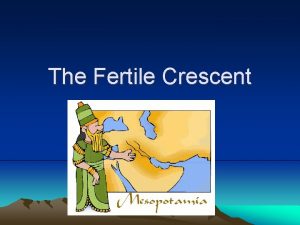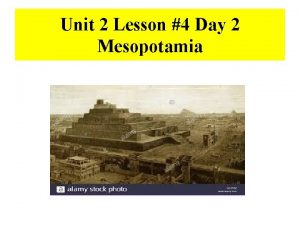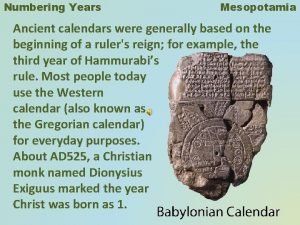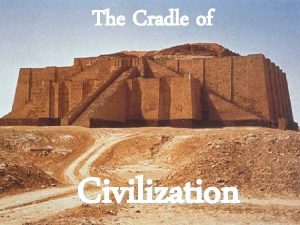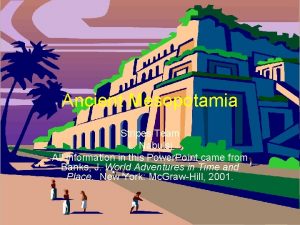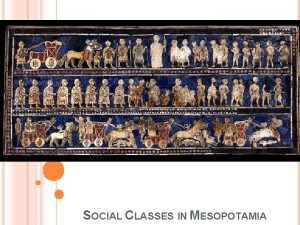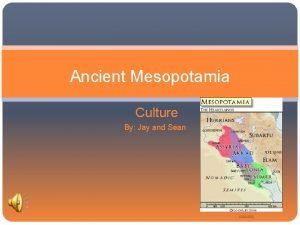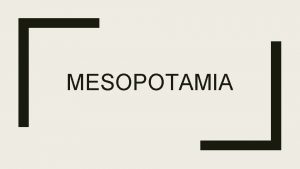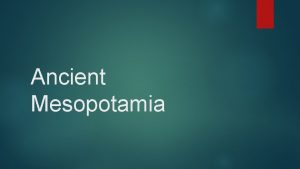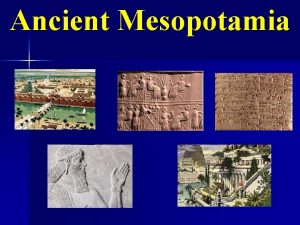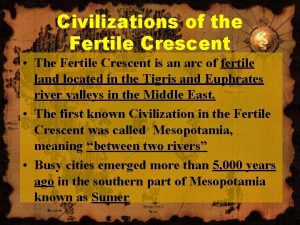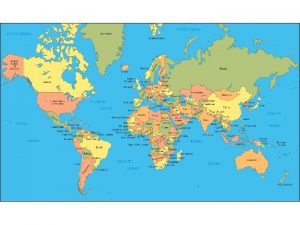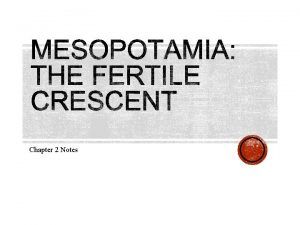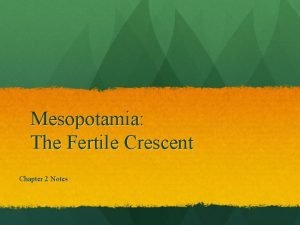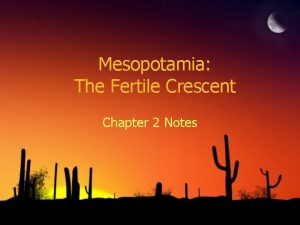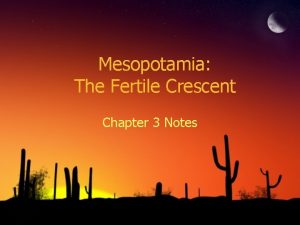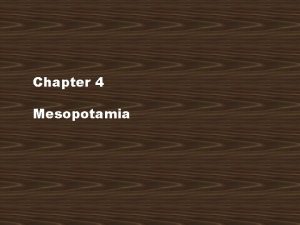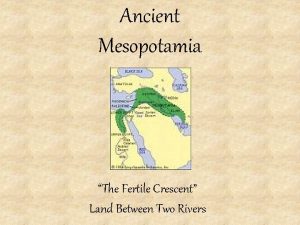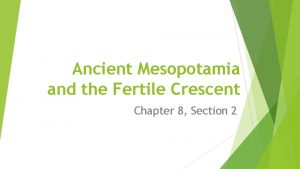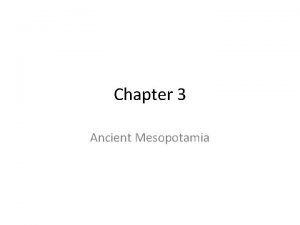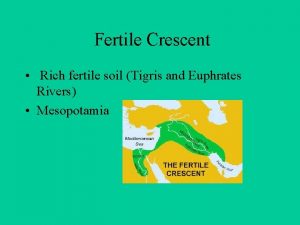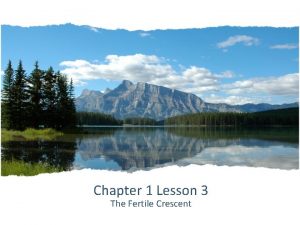The Fertile Crescent Ancient Mesopotamia The Fertile Crescent




























- Slides: 28

The Fertile Crescent Ancient Mesopotamia




The Fertile Crescent • Area from the Persian Gulf through the Tigris and Euphrates river valleys along the Mediterranean Sea • Area of Middle East where civilization began. • Fertile - crescent shaped land. • Large supply of sheep, goats, and wheat in the wild. Nomads settle City-states are formed

Things to Know • River valleys prime locations for cultures to develop into civilizations- good for travel, trade, and farming. • A civilization is a highly developed culture complete with religion, government, social class structure, and writing system.

Life in the Tigris and Euphrates River Valleys Challenges • Rivers are unpredictable • Sometimes the rivers overflow and floods destroy crops • Other times the rivers do not overflow when expected causing damage to dehydrated crops. Solutions • Build levees (dams and channels) to control floods. • Build walls, waterways and ditches to bring water to crops( irrigation)

Mesopotamia • • • Eastern part of Fertile Crescent Present day - Iraq Also known as the land between 2 rivers – 1. Tigris River – 2. Euphrates River

People of the Fertile Crescent • • Sumerians Akkadians Babylonians Assyrians Hittites Chaldeans Persians

Sumer • City-states rose about 3000 B. C. between the Tigris and Euphrates Rivers. • Developed a system of irrigation (bringing water to crops through a system of a waterways, walls and ditches). • Each city-state independent of one another desire for more land War

Sumerian Developments • • • System of writing- cuneiform-wedge shaped symbols First people to live in a city-state Divide the year Divide the circle into 360 parts Developed a 12 month calendar based on the lunar cycle used the wheel and made vehicles Invented the plow and the sail boat Number system based on 60 Used geometry to measure fields and put up buildings

Sumerians and Religion q Belief in many gods. q Each god has powers over nature or activity. q Temple called ziggurat built to honor chief god. Large tiered structure with a shrine on the highest tier q Belief that gods speak to priests

Sumerian Professions • • • Farmers Tradesmen Merchants Soldiers Government officials Artisans- skilled workers

Sumerian Social Class Structure 1. Upper Class-kings, priests, government officials 2. Middle Class- artisans, merchants, farmers, and fishers. 3. Slaves-criminal, pay off debt, and prisoners of war

The Development of Writing in Sumer • Wedge shaped symbols called cuneiform. • Used to keep track of records and business transactions. • Writing material 1. Damp clay 2. Sharp ended reed called a stylus

Writers and Literature in Sumer • People that keep written records are called scribes • Oldest known stories are from Sumer -Epic of Gilgamesh

Akkadians Conquer Sumerian City-States • Conflicts , arguing, and wars weaken Sumerian city-states • 2340 B. C. Sargon (Akkadian King) conquers and unites Mesopotamia First empire formed - lasts for 200 years

Babylonians • • • Babylon built by Euphrates River Emerged 1800 s B. C. 1792 B. C. Babylonian King Hammurabi conquers Mesopotamia • Study astronomy and astrology • Horoscopes

Hammurabi • King of Babylonians • Made Babylon powerful • Best known for his laws known as the Code of Hammurabi • • 282 laws covering all parts of society An eye for an eye justice

Code of Hammurabi

The Assyrians • 1, 000 years after Hammurabi • Need for strong army to protect lands leads to becoming conquerors • Strong -war seeking group • Lion hunters

Assyrian Army • • • Strong Ferocious Organized – 1. foot soldiers-daggers and spears – 2. chariot riders – Soldiers on horseback

Assyrian Government • • • Capital- Ninevah on Tigris River Ruled by king Empire divided into districts called provinces

Assyrian Developments • • • Built a system of connecting roads Created the first library-25, 000 tablets First to develop a standing army Developed a mail service Large temples and palaces

Assyrian difficulties People treated harshly Many Rebellions and Mercenaries hired Downfall of Assyrians

The Chaladeans • Control Mesopotamia from 605 B. C. -562 B. C. • Descendants of Babylonians • Rebuild Babylon World’s largest and richest city-protected by brick wall

Creation of one of the seven wonders of the ancient world Hanging Gardens of Babylon-built by King Nebuchadnezzer

Achievements q. Sun dial q. Seven day week
 Fertile crescent
Fertile crescent Fertile crescent
Fertile crescent Babylon
Babylon Geography of the fertile crescent
Geography of the fertile crescent Unit 2 lesson 4 fertile crescent
Unit 2 lesson 4 fertile crescent Fertile crescent ap human geography definition
Fertile crescent ap human geography definition Where's the fertile crescent
Where's the fertile crescent Fertile crescent
Fertile crescent Fertile crescent on world map
Fertile crescent on world map Geography of the fertile crescent
Geography of the fertile crescent The fertile crescent is the arc of land that
The fertile crescent is the arc of land that Mesopotamia environmental challenges
Mesopotamia environmental challenges Fertile crescent
Fertile crescent Fertile crescent agricultural hearth
Fertile crescent agricultural hearth Geography of the fertile crescent
Geography of the fertile crescent Multilingual state
Multilingual state Esopotamia
Esopotamia Geography of the fertile crescent
Geography of the fertile crescent Unit 2 lesson 4 fertile crescent
Unit 2 lesson 4 fertile crescent Ancient mesopotamia calendar
Ancient mesopotamia calendar Mesopotamia language
Mesopotamia language Ancient mesopotamia timeline
Ancient mesopotamia timeline Ancient mesopotamia
Ancient mesopotamia Social classes in mesopotamia
Social classes in mesopotamia Ducksters ancient mesopotamia
Ducksters ancient mesopotamia Means of communication in ancient times
Means of communication in ancient times Ancient india vs ancient china
Ancient india vs ancient china Pharaon
Pharaon Mezzaluna fertile
Mezzaluna fertile
